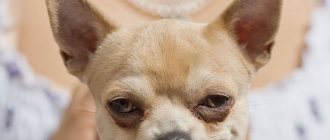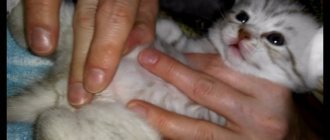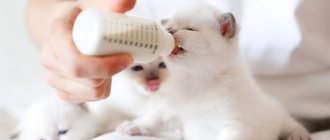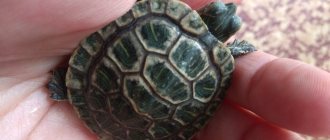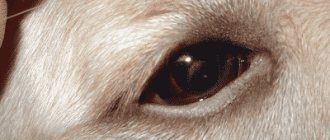Main reasons for color change
Eye color depends on the amount of pigment in the cells of the cornea, the formation of which begins in the embryonic period.
The cat's gestation period ranges from 55 to 63 days. In this short period of time, inside the mother, two united cells must develop into a relatively large, smoothly working organism.
The mother's resources are limited, so the melanin she synthesizes is primarily sent to the skin and fur cells of the fetus. This allows you to quickly form reliable covers for effective thermoregulation and protect the kitten from an aggressive external environment. In this case, the cells of the iris are deficient in melanin, which is why they remain colorless during birth and several weeks later. As the kitten grows, its eyes gradually open, vision becomes clearer, and the eyes acquire a color dictated by breed and heredity.
Anatomically, the cat's cornea consists of two layers: stroma (upper) and epithelium (lower).
The degree of saturation of the stroma with melanin determines the shade of the kitten’s eyes. If there is little of this substance in the cells of the iris, the eyes will be blue or blue. If a little more - green. With a high melanin content, the eyes turn coppery brown.
Factors influencing the final eye color of an animal
Thus, pigment is responsible for eye color. More precisely, its quantity. But the total volume of pigment accumulated in the iris is a factor of exclusively genetic, hereditary nature. The color of the animal’s eyes and the speed at which the pigment moves into the iris depend on heredity. This means that one cat's eyes will acquire their final color before the age of six months, while another cat's eyes will gradually change color over several years. There is no way to change all this. To understand what the kitten's eye color will be in the future, you need to look at its parents.
By the way, scientists have long established how exactly the amount of melanin affects the color of the iris. If there is a lot of pigment, it will be colored yellowish-brown. With an average number of eyes it will be green. If there is very little melanin in the iris, then an adult cat’s eye color will be “baby”, i.e. blue or bluish-gray. To fix the last color, by the way, many breeders work for decades, achieving sustainable inheritance of this factor.
Can eye color not change?
The embryo inside the uterus is not exposed to ultraviolet radiation, so during pregnancy it receives an extremely small amount of melanin from the mother. This explains the fact that every kitten is born with closed eyelids, which open only in the third week of life.
The main function of melanin is to protect the body from exposure to ultraviolet rays.
The eyelids protect the delicate pupils, devoid of pigment, from the sun's rays. As the iris matures, the eyes open, but for a long time retain a dull gray-blue tint due to the translucent film.
The idea that there are certain breeds or individual cats that are born with a constant eye color is erroneous.
The fact is that the stages of formation of a cat’s body are standard for all breeds and depend on the characteristics of the blood lines. Even a blue-eyed cat will have a very different iris at birth and as an adult: as it grows, the cloudy bluish-gray will change to a bright icy-clear or deep blue color.
When to expect changes
The process occurs differently in different breeds, with time frames ranging from 1-12 months. In outbred animals it often begins at the age of 1-1.5 months. In Scottish and other purebred kittens, eye color usually changes between 4 and 12 months. The so-called “true cat color” of the iris is finally formed towards the end of the second year of life. On days 10-14, when a newborn kitten opens its eyes, they are usually covered with a cloudy film, which is why they appear cloudy. Approximately by a month, the film disappears, so the iris appears brighter. Then, as the pigment grows and accumulates, its color changes and the shade becomes more pronounced. It is quite difficult to determine exactly what it will be like in the end, since the color palette is very diverse: from gray to red (for albinos).
The main colors of cat eyes are:
- green;
- yellow;
- copper;
- blue.
Although blue eyes in an adult animal are, in fact, a sign of insufficient production of melanin by the body. In its absence, short waves of visible light (which the human eye perceives as blue) are scattered in the iris, as happens in the atmosphere, which is why the eyes appear blue, like the sky.
According to the observations of felinologists, if a kitten is born with yellow eyes, over time they become brighter (even copper, amber), but never acquire a blue tint. Although a change from blue to yellow and even brown is quite possible.
If you want to become the owner of a kitten with a certain eye color, it is better to take your pet home after 4 months. By this time, the main shade is usually formed, which over time can only become more saturated and deeper.
When do major changes occur?
The first changes in the shade of the cornea can be seen already in the fourth week of a kitten’s life. Melanin begins to concentrate in the pigment centers of the iris, and gradually small patches of a different color appear on the bluish field.
By 4 months, you can get an impression of the approximate color of the pupils. The final shade will be established only upon reaching the age of two, when the formation of the body is completed and the kitten enters the maturity phase.
Since the shade of the iris is a determining factor for the breed, it is recommended to choose a kitten at the age of 4-6 months. At this time, even an inexperienced breeder will be able to correctly determine whether the future pet meets the breed standards.
How kittens develop further
When their eyes open and vision appears, kittens discover that the world is interesting and colorful. They begin to explore their environment with curiosity. By the end of the third or fourth week, babies can stand, walk staggering, and try to maintain balance.
The kittens begin to actively play with each other, become nimble, and difficult to keep track of. They can already empty themselves on their own (up until this point, the cat licked them several times a day, massaged their tummy, and that was the only way they could go to the toilet). By this age, babies begin to demand to be fed, because mother’s milk alone is no longer enough for them.
You can feed them:
- cottage cheese;
- egg yolk;
- milk;
- small pieces of minced chicken.
By the sixth week of life, kittens' need for mother's milk weakens. And at eight weeks, the baby has already formed a certain diet. At this age it is already possible to separate children from the cat.
From three months, babies are actively developing and gaining weight (at birth, kittens weigh on average 80 - 100 grams). Further, with normal development, weekly weight gain ranges from 50 to 100 grams. This continues for up to six months.
At the age of four to seven months, kittens begin to replace their baby teeth with permanent ones. New teeth are sharper, fangs become straighter.
So, in this article we found out when kittens’ eyes open, they begin to see and hear, and we looked at the issues of the formation and development of babies up to six months of age.
Standard colors
The standard eye shades for cats are:
- Green. Allowed in cats with a predominance of black, blue, lilac color, coat of cinnamon, fawn, chinchilla color.
- Yellow. Characteristic of tabby cats.
- Copper. Allowed for cats with black, chocolate, lilac, blue, red, cream color.
- Icy and light blue. Acceptable for all white cats.
However, white cats with blue eyes are often deaf in both ears. Among white pets with one blue eye (heterochromia), unilateral deafness (on the side of the blue eye) is observed.
White mark
What kind of eyes do British cats with white markings, the so-called bicolors, harlequins and vans have? In this case, everything depends on the main color - the color of the cat’s eyes should correspond to it. Most often, British cats with white spots are yellow-eyed or green-eyed, but sometimes there are rare heterochromic specimens among them.
However, all these nuances are important only for those who actively participate in exhibitions or are involved in breeding cats. For most ordinary cat owners who have British cats, the color of their pets' eyes does not matter. Yellow, green, blue or even different ones - they are still the most favorite!
Breed differences
The standard for each breed contains a list of acceptable iris shades.
All Thai cats must have blue eyes. The aquamarine hue of their pupils should be bright and deep. Dullness is considered a disqualifying factor, excluding the animal from breeding work. Similar requirements apply to representatives of the Siamese breed.
Burmese beauties should have eyes ranging from a rich golden to lemon shade. Any deviation from the standard is unacceptable. Oriental cats are distinguished by grass-green eyes of varying intensity. For British and Scottish cats, copper, amber or terracotta colored eyes are preferred. And a green iris will ruin the exhibition career of even the most beautiful British woman.
Maine Coons can have corneas of any shade. The main thing is that the color is as pure as possible and does not contain other inclusions. The same requirement is prescribed for representatives of the Bengal breed. The only exceptions are individuals with the lynx point (snow) color, which must be blue-eyed.
Siberian cats are the pride of Russian felinology. Green and yellow shades of the pupils are considered the most acceptable for them. However, the color-point Siberian subspecies Nevskaya Maskaradnaya should have a piercing sky-blue gaze.
What determines the timing of eye opening in kittens?
The time it takes for babies to open their eyes is influenced by many factors.
Breed
It is genetically determined that in kittens of different breeds, the opening of the eyes takes a different period of time:
- Newborn Ragdolls are characterized by extremely slow development of their visual organs - pets begin to see in the 3rd week of life and later.
- Maine Coons begin to see sight 14-16 days after birth.
- Cubs of Siberian breed pets open their eyes at 12-17 days, just like British ones.
- Small Cornish Rex can see at 5-7 days.
- Kittens of Siamese, Abyssinian and Sphynx breeds are sometimes born with open eyelids and vision becomes focused by 3-4 days.
- Scottish Fold, British and Bengal newborns begin to see 7-9 days after birth.
- Kittens of short-haired breeds develop faster than long-haired ones.
Floor
In female kittens, the process of opening their eyes is faster than in males. In addition, the stronger and more active the kitten, the sooner they will open. It is useful to hold babies in your hands or stroke them. The cat begins to lick the offspring more intensely and more often to get rid of foreign odors, thereby accelerating the development process of the kittens.
Date of birth
The period of gestation of babies affects the speed of their development after birth.
The longer a cat carries offspring, the faster the newborns open their eyelids, the higher the likelihood of them being born with open ones. In this case, it is necessary to pay special attention to moisturizing the membranes of the eye, otherwise the development of diseases is likely.
Health status
Healthy babies who have enough nutrients and are well-groomed open their eyes much earlier than those whose condition is worse. Viruses and the presence of congenital pathologies slow down the development process.


